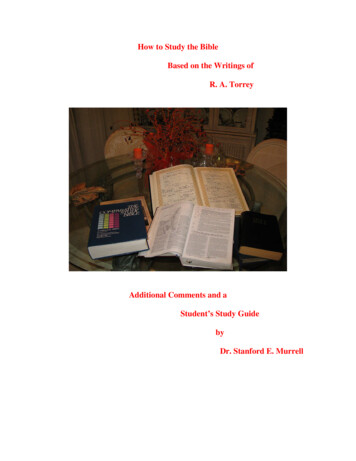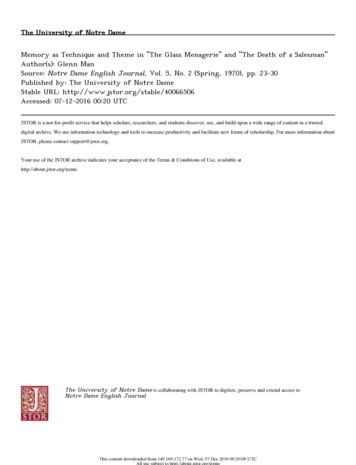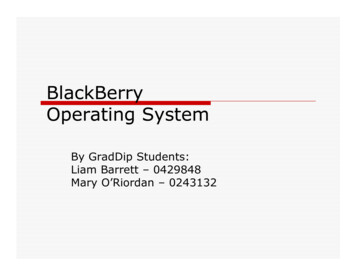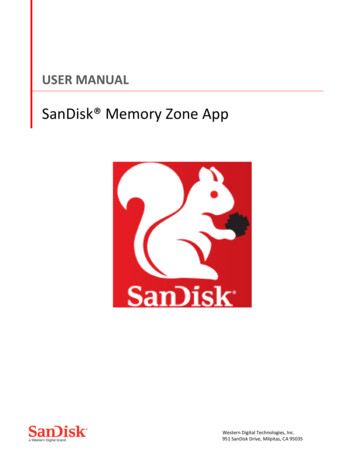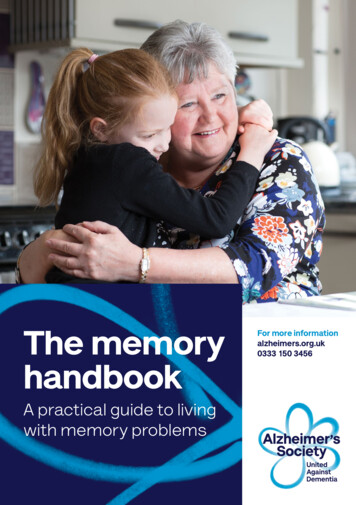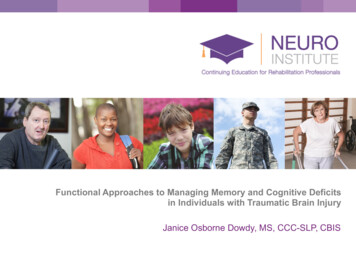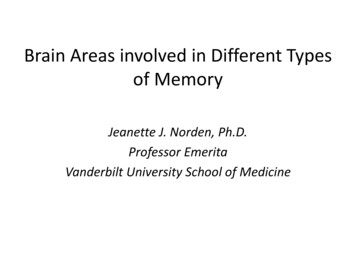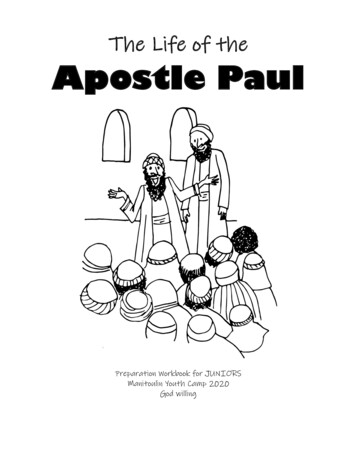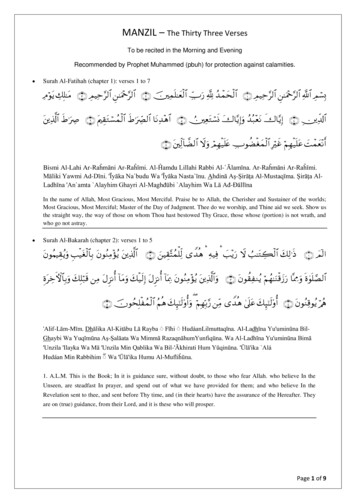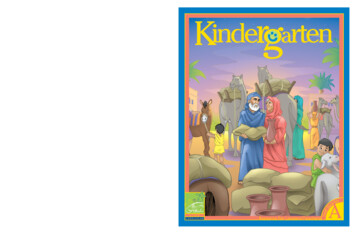
Transcription
First Quarter — Year AMy Memory Verses1 “ God saw all that he had made, and it was very good.”GENESIS 1:31, NIV.2 “ God said, ‘Let us make mankind in our image.’ ”GENESIS 1:26, NIV.3 “ God blessed the seventh day and made it holy.”4 “ The L is good and his love endures forever.”5 “ We will obey the voice of the L .”GENESIS 2:3, NIV.ordJEREMIAH 42:6, NKJV.6 “ For what you have done I will always praise you.”7 “ Great is the L , and most worthy of praise.”I have set my rainbow in the clouds, and it will be8 “ [a]sign.”KINDERGARTENordPSALM 100:5, NIV.PSALM 52:9, NIV.ordPSALM 48:1, NIV.10 “Worship the Lord with gladness.” PSALM 100:2, NIV.Let’s not have any quarreling between you and11 “ me.”12 “ I will accept nothing belonging to you.”13 “ Let us love one another, for love comes from God.”GENESIS 13:8, NIV.GENESIS 14:23, NIV.1 JOHN 4:7, NIV.*EKT220101*EKT220101If you have a QRcode reader onyour smartphone orcomputer: loadthe reader, pointyour camera at thisgraphic, and visitour site.Resource for Leaders/Teacherste rAtQCORINTHIANS 14:1, NIV.Firs“ Follow the way of love.” 1Sabbath School Resource for Leaders/Teachers9GENESIS 9:13, NIV.rua
If you have a QRcode reader onyour smartphone orcomputer: loadthe reader, pointyour camera at thisgraphic, and visitour site.Leader/Teacher Guidewww.gracelink.netA Sabbath School Bible Study Guide for Kindergarten ChildrenGraceLink Sabbath School CurriculumYear A, First QuarterEDITORIAL ASSISTANTKATHLEEN D. SOWARDSWORLD SABBATH SCHOOL DIRECTORSRAMON CANALS, JIM HOWARDGENERAL CONFERENCE ADVISERCONSULTING EDITORDESIGNDESKTOP TECHNICIANILLUSTRATOR: SABBATH SCHOOL LESSONSILLUSTRATOR: DO AND SAYLINE ART ILLUSTRATORTED N. C. WILSONARTUR STELEREVIEW AND HERALD DESIGN CENTERTONYA BALLDAN SHARPKINCHI MARC LATRIQUEMARY BAUSMANCIRCULATIONREBECCA HILDEA Publication of the Sabbath School/Personal Ministries DepartmentGeneral Conference of Seventh-day Adventists 12501 Old Columbia PikeSilver Spring, MD 20904-6600, U.S.A.Texts credited to ICB are from the International Children’s Bible , copyright 1986, 1988, 1999, 2015 by Tommy Nelson.Used by permission. All rights reserved.Texts credited to NIV are from the Holy Bible, New International Version. Copyright 1973, 1978, 1984, 2011 by Biblica, Inc.Used by permission. All rights reserved worldwide.Texts credited to NKJV are from the New King James Version. Copyright 1982 by Thomas Nelson, Inc. Used by permission. Allrights reserved.Kindergarten Sabbath School Leader/Teacher Guide (ISSN 0163-8793). Vol. 46, No. 1, First Quarter 2022. Published for theGeneral Conference of Seventh-day Adventists by the Pacific Press Publishing Association, 1350 N. Kings Road, Nampa, ID83687, U.S.A. Text copyrighted 2022 by the General Conference of Seventh-day Adventists . All rights reserved. No part ofthe Kindergarten Sabbath School Leader/Teacher Guide may be edited, altered, modified, adapted, translated, reproduced, orpublished by any person or entity without prior written authorization from the General Conference of Seventh-day Adventists .The division offices of the General Conference of Seventh-day Adventists are authorized to arrange for translation of theKindergarten Sabbath School Leader/Teacher Guide, under specific guidelines. Copyright of such translations and their publicationshall remain with the General Conference. “Seventh-day Adventist,” “Adventist” and the flame logo are registered trademarksof the General Conference of Seventh-day Adventists and may not be used without prior authorization from the GeneralConference, 12501 Old Columbia Pike, Silver Spring, Maryland 20904-6600, U.S.A. Art copyrighted 2003 by the Review andHerald Publishing Association.Postmaster: Send address changes to Kindergarten Leader/Teacher Guide, Circulation P.O. 5353, Nampa, ID 83653-5353.Periodicals postage paid at P.O. Box 5353, Nampa, ID 83653. Single copy, US 24.99 plus postage. One year, United States:US 67.80; Canada and foreign: US 75.80. Prices subject to change without notice.Printed in U.S.A.1
The Kindergarten WritersAudrey Boyle Andersson—SwedenVikki Montgomery—Maryland, USAJackie Bishop—California, USARebecca Gibbs O’Ffill—Maryland, USADeeAnn Bragaw—Colorado, USAEvelyn Omaña—VenezuelaLinda Porter Carlyle—Oregon, USADenise Pereyra—California, USAHelga Eiteneir—GermanyDawn Reynolds—Maryland, USARené Alexenko Evans—Tennessee, USAJanet Rieger—AustraliaAdriana Itin Femopase—ArgentinaJudi Rogers—Maryland, USARené Garrigues-Goodwin—Washington,USA Denise Ropka-Kasischke—California, USAFeryl Harris—West Virginia, USADonna Meador—Washington, USA2Eileen Dahl Vermeer—Canada
ContentsGRACE Grace is God’s love for us.1 “In the Beginning . . .” (January 1) - - - - - - - - - - - - - 102 God’s Friends (January 8) - - - - - - - - - - - - - - - - - - - - 203 A Special Day (January 15) - - - - - - - - - - - - - - - - - - - 304 Hiding From God (January 22) - - - - - - - - - - - - - - - - 40WORSHIP We praise God for His loving care.5 Noah Builds a Boat (January 29) - - - - - - - - - - - - - - - 506 An Animal Parade (February 5) - - - - - - - - - - - - - - - - 607 A Floating Zoo (February 12) - - - - - - - - - - - - - - - - - 708 God’s Rainbow Promise (February 19) - - - - - - - - - - - 80COMMUNITY Community means loving one another.9 Abram Follows God (February 26) - - - - - - - - - - - - - - 9010 Abram’s Altars (March 5) - - - - - - - - - - - - - - - - - - - 10011 Lot Chooses First (March 12) - - - - - - - - - - - - - - - - 11012 Abram to the Rescue (March 19) - - - - - - - - - - - - - 12013 Sarah’s Special Baby (March 26) - - - - - - - - - - - - - - 1303
Basic Needs of Children*All children have certain basic needs as well as needs that are specific to their age and stage ofdevelopment. The basic needs of children are:Physical Food Warmth ShelterMental P ower—to make choices and follow plansEmotional A sense of belonging Expressions of unconditional love andacceptance Approval and recognition Freedom within defined boundaries Humor—a chance to laughSpiritual An all-knowing, loving, caring God F orgiveness of wrongs and a chanceto start over Assurance of acceptance with God E xperience in prayer, answers to prayer A chance to grow in grace and in theknowledge of GodThe Kindergarten ChildIn the Seventh-day Adventist Church we advocate kindergarten for children ages 3-5. However,the development of children varies from child to child. Therefore, a knowledge of each child in yourSabbath School is important. Generally, the description below is true of children ages 3-5.Physical Start developing large muscle coordination Lack a sure sense of balance Are extremely active Tire easily, but revive soon after resting Lack fine muscle coordination Are curious and like to explore theirenvironment Learn by exploringMental Are capable of limited listening and understanding without the help of a visual cue,such as seeing the object being discussed Have quick memory Memorize things they don’t understandEmotional Cry easily Are capable of verbalizing emotionalresponses Learn to delay gratification of needs without losing equilibrium Learn ways to express negative emotionsSocial/Relational Are self-centered—the world revolvesaround them4 Play alone in the presence of their friends,rather than playing with their friends Like to make friends and be with friendsDevelopmental NeedsIn addition to the basic needs mentionedearlier, kindergarten children need: Freedom—to choose and to explore withinlimits Power—to have some autonomy in learning situations Limits—safe boundaries that are set byparents and teachers Fun—learning through play, enjoying success Discipline and training—to provide safetyand structure in their livesSpiritual NeedsKindergarten children need to know: God loves them and cares for them How to show respect for God God made them, knows them, andvalues them The difference between right and wrong How to choose the right with God’s help
General RulesA child’s attention span, in minutes, is their age plus one. Thus, an average 3-year-old has a potential attention span of fourminutes, provided they are interested in what is happening.Kindergarten children: E njoy repetition—provided they don’t tire Are beginning to reason from simple cause to effect Make some generalizations—often incorrectly L earn best by active participation Have a short attention span—three to six minutes*Children’s Ministries: Ideas and Techniques That Work, ed. Ann Calkins (Lincoln, Nebr.: AdventSource, 1997).About MaterialsAs you follow the natural learning sequence outlined in each lesson, you may want to adapt activities for use in yourparticular situation, and this may require a change in the need for materials. Look ahead at the Program Outline for eachweek’s program so you can be prepared with the materials suggested.Supplies Frequently Used in KindergartenPaperq butcher paper (roll)q c onstruction paper(various colors)q drawing paperq finger-painting paperq poster boardq writing paperArt suppliesqqqqqqqqqqqqq aluminum foilcotton balls or polyester fiberfillcraft stickscrayons, markers, colored pencilsfinger paints and watercolorsglue or glue stickshole punchmagazinesmagnetic tape (stick-on)pencilsplastic wrapplay dough or modeling clayscissors (blunt-nosed)q stamp pads (various colors)q stapler and staplesq stringq tape (cellophane, masking, etc.)q thread, several colorsq t oilet paper or paper towel rollsq(empty)yarn, several colorsOtherq adhesive bandagesq audio music playerq bags, paper and plastic, all sizesq balloonsq beanbagq blanketsq blindfold for each childq blocks, boxes, or Legosq b oxes, large cardboard (appliancesize)q c henille sticks or pipe cleanersq c ostumes, Bible-times, for adultsand childrenqqqqqqqqqqqqqqqqqqqqqc rown for each childc ups, paper and plasticd olls (baby dolls)fabric piecesflashlightgifts (inexpensive)m agnets, smallpaper clips (steel)paper platespaper towels/baby wipesp lastic or newspaper to covertablesr ecorded nature soundsrubber bandss andwich bags, plastic sealables eeds (rice, beans, etc.)shoe boxess mocks/old shirts to coverchildren’s clothesstickers, large varietytowels, smallt oy musical instrumentstoy stuffed animals5
Additional Supplies Needed This QuarterIn addition to those materials frequently used in kindergarten, specific items may be used only once during the quarter. Alist of such items is included here for your convenience. Keep in mind that this list DOES NOT include everything needed toteach a given lesson.Lesson 1qnature items (leaves, plants,flowers)q magnifying glassq bubblesq recorded water soundsq fresh fruitq tape or other adhesive, felts andflannel or bulletin board.Lesson 2q live petq p icture of a friend (your friend)q 8" x 10" (or larger) emptypicture frameLesson 3qqqqparty supplies (streamers,balloons, hats, etc.)rhythm instruments(pots, pans, wooden spoons,sticks, etc.)blanket or beach towelor large boxparty invitationsLesson 4qqinexpensive wrapped giftfor each child fig leaf coat and leaf pattern (seep. 141)Lesson 5q basin/bowl for waterq things that float or sinkq carpenter’s tools (real or play)q fruitq pillowq empty medicine bottleq p icture of a mother and fatherq sunglasses or eyeglassesq rulerq coin purse with coinsqw ords cut from newspaperq6or magazineark puzzle pattern (see p. 140)Lesson 6qqpictures/photos of parents,teacher, pastor, house, church,food, clothesf inger puppet patterns(see p. 142)Lesson 7qqqqqqqqqqqmirrorwool fabricnoisy itemscalendarclockraven propdove proptwig with a green leafbox wrapped as Christmas giftbirthday candlesweet treatLesson 8qqqqqqqqqqqqrubber ballsprism or “sun catcher” glassbubble solution and blower“rainbows” made from 12-inchlong dowels with ribbons ofrainbow colors attachedglass jar with lidlarge wall calendardirtstonestwigs, two small twigs foreach childsmall weights (such as metalwashers)thick branch you can’t breakrainbow pattern (see p. 143)Lesson 9qqqqsuitcasewarm- and cold-weather clothesmap sheep/camel pattern (see p. 144)Lesson 10q i ngredients for trail mixqqqq(see Readiness Activity B)mixing bowl and spoonsmall paper cups or smallsealable plastic bagssmall plastic containers with lidssix stonesLesson 11qqbowlvariety of fruit or individuallywrapped candiesq two clear pitchers and anotherempty containerq red food coloringq sugar, saltq small paper cupsq a bell or buzzer (optional)q scraps of ribbon or fabricq Number 1 pattern (see p. 142)Lesson 12qqqqqqqsimple objects (toy, dish towel,article of clothing, cup or plate)empty food wrapperwrapped shoe box with lidwrapped separately10 identical coins (or substitute10 like items)10 food items10 paper or plastic cupsbeanbag or small ball or stuffedtoyLesson 13q b aby, mother, grandmother (orqqqqqqpictures)baby-care itemsserving traycrackers, pita bread (pieces) ordried fruit piecesadult male and femaletwo adult Bible-times costumesbaby doll in a blanket
Lesson Bible Story ReferencesMemory MessageVerse (abridged)MaterialsGRACE: Grace is God’s love for us.Lesson 1Jan. 1God creates theworld.Genesis 1; PP 44;SC 9–15Genesis 1:31,NIVGod made the worldfor us.See p. 11.Lesson 2 God createsJan. 8people.Genesis 1:24–31;2:4–23; 3:20;PP 45–47Genesis 1:26,NIVGod made us to beHis friends.See p. 21.Lesson 3Jan. 15God creates theSabbath.Genesis 2:1–3;Genesis 2:3, NIV God made the Sabbath See p. 31.PP 47, 48for us.Lesson 4Jan. 22Adam and Evedisobey.Genesis 3:1–21;PP 52–62Psalm 100:5,NIVGod loves us allthe time.See p. 41.WORSHIP: We praise God for His loving care.Lesson 5 God warns Noah. Genesis 6:5–18;Jan. 29PP 90–97Jeremiah 42:6,NKJVWe worship byobeying.See p. 51.Lesson 6Feb. 5Animals enterthe ark.Genesis 6:19–7:24; Psalm 52:9, NIV We thank God for HisPP 97–104care.See p. 61.Lesson 7Feb. 12God protectsthe ark.Genesis 7:6–24;Psalm 48:1, NIV We thank God for8:1–12; PP 105keeping His promises.See p. 71.Lesson 8Feb. 19God sends arainbow.Genesis 8:20–9:17; Genesis 9:13,PP 105–110NIVSee p. 81.We thank God for Hispromises.COMMUNITY: Community means loving one another.Lesson 9 God callsFeb. 26Abram’s family.Genesis 12:1–9;1 CorinthiansActs 7:2–7;14:1, NIVHebrews 11:8–12;PP 125–131Lesson 10 Abram’s familyMar. 5worships God.Genesis 12:7–9;Psalm 100:2, NIV Christian familiesPP 127–131worship God.See p. 101.Lesson 11 Abram and LotMar. 12 separate.Genesis 13;PP 132, 133Genesis 13:8,NIVWe put others first.See p. 111.Lesson 12 Abram rescuesMar. 19 Lot.Genesis 14;PP 134–136Genesis 14:23,NIVWe serve others outof love.See p. 121.Lesson 13 Sarah has a baby. Genesis 18:1–15; 1 John 4:7, NIV We love each other.Mar. 2621:1–7; PP 145, 146See p. 131.Christian familiesfollow God.See p. 91.7
To the Leaders/TeachersThese guides were developed to:A. Introduce the lesson on Sabbath. The child then reviews and appliesthe principles studied with the help of their parents and Bible study guidesduring the week. In this way, the lessons learned in Sabbath School becomea vital part of the child’s growing faith experience. Memory verses, whichare also learned in Sabbath School, are reviewed and reinforced during thefollowing week, connected in the child’s mind with the interesting learningactivities they have already experienced.B. Focus the entire Sabbath School time on one message. These messages each relate to one of the four dynamics of a growing faith experience:grace (God loves me), worship (I love God), community (we love eachother), and service (God loves you too).4Sharing the1TheLesson gives theReadinesschildren a chance toActivities give thedevelop ways that they canchildren a reason to wantshare their new concept withto learn the lesson. This sec-others. This section appeals to dy-tion appeals to imaginativenamic learners, who ask, “What canthis become? What can I do to sharelearners, who ask, “Why should Ilearn this?”this idea with others?”ThePrayer and Praise sectionis the time-honored “business” of SabbathApplying theSchool and may be used at any point duringLesson gives the children a chanceto explore how the lesson can beapplied in a practical way intheir daily lives. This sectionappeals to commonsense3learners, who ask,“How does it workin my life?”Thethe lesson; however, it is recommendedthat you begin with ReadinessBibleActivities, even while somechildren are stillLesson lets youteach the children the content in a way that involves them.This section appeals to theanalytical learners, who ask,“What do I need to learn?”28arriving.
C. Reach each child in the way they learn best. By following the naturallearning sequence on which these outlines were based, you will also connectstudents with “the message” for the week in a way that will capture eachone’s attention and imagination.D. Give students active learning experiences so they can more readilyinternalize the truths being presented. These experiences are followed bydebriefing sessions in which you ask questions that lead the children toreflect on what they experienced, interpret the experience, and apply thatinformation to their lives.E. Involve the adult Sabbath School staff in new and flexible ways. A very small Sabbath School can be managed by one adult. A larger Sabbath School can be managed by one leader/teacher withother adult volunteers to facilitate the small group interaction. This givessmall group facilitators a maximum involvement with the students andtheir dynamic learning, while requiring a minimum of preparation on thefacilitator’s part. A creative alternative is to enlist leaders/teachers with different personallearning styles to lead different segments of the program.To use this guide . . .Try to follow the natural learning cycle outlined, but adapt it as necessary tomake the program work in your particular situation.Look ahead at the Program Outline for each week’s program so you can beprepared with the simple materials suggested.9
KINDERGARTEN Sabbath School Resource for Leaders/Teachers “God saw all that he had made, and it was very good.” GENESIS 1:31, NIV. “God said, ‘Let us make mankind in our image.’ ” GENESIS 1:26, NIV. “God blessed the seventh day and made it holy.” GENESIS 2:3, NIV. “The L o
